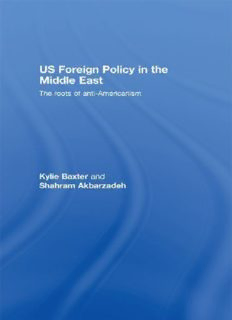
US Foreign Policy in the Middle East: The Roots of Anti-Americanism PDF
Preview US Foreign Policy in the Middle East: The Roots of Anti-Americanism
US FOREIGN POLICY IN THE MIDDLE EAST Over the last 60 years, Washington has been a major player in the politics of the Middle East. From Iran in the 1950s, to the Gulf War of 1991, to the devastation of contemporary Iraq, US policy has had a profound impact on the domestic affairs of the region. Anti-Americanism is a pervasive feature of modern Middle East public opinion. But, far from being intrinsic to ‘Muslim political culture’, scepticism of the US agenda is directly linked to the regional policies pursued by Washington. By exploring critical points of regional crisis, Kylie Baxter and Shahram Akbarzadeh elaborate on the links between US policy and popular distrust of the United States. The book also examines the interconnected nature of events in this geostrategically vital region. Accessible and easy to follow, this book is designed to provide a clear and concise overview of complex historical and political material. Key features include: • maps illustrating key events and areas of discontent; • text boxes on topics of interest related to the Arab–Israeli wars, Iranian politics, foreign interventions in Afghanistan and Iraq, the wars of the Persian Gulf, September 11 and the rise of Islamist movements; and • further reading lists and a selection of suggested study questions at the end of each chapter. US Foreign Policy in the Middle East: The roots of anti-Americanism provides students and researchers insight into the popular discontent generated by decades of US policy in the Middle East. Dr Kylie Baxter is a researcher at the National Centre of Excellence for Islamic Studies, the University of Melbourne, Australia. Her research focuses on Islamic politics and conflict in the Middle East. She is also the author of British Muslims and the Call to Global Jihad (Melbourne: Monash Asia Institute Press, 2007). Associate Professor Shahram Akbarzadeh is Deputy Director of the National Centre of Excellence for Islamic Studies, the University of Melbourne, Australia. His research focuses on Australian Muslims, international relations and Islamic politics. He is also the author of Uzbekistan and the United States: Islamism, Authoritarianism and Washington’s Security Agenda (London: Zed Books, 2005). US FOREIGN POLICY IN THE MIDDLE EAST The roots of anti-Americanism Kylie Baxter and Shahram Akbarzadeh CONTENTS List of maps Acknowledgements Introduction 1 The Middle East in the Colonial Period Introduction The fall of the Ottomans and the Hashemite Dynasty The Sykes–Picot Agreement of 1916 and the balfour declaration of 1917 The post-war era: the King–Crane commission and the Mandates 2 Great Power Influences, Zionism and the Middle East Introduction Zionism: the road to statehood Zionism during the war Al-Nakba/the Israeli War of Independence Conclusion 3 Israel and the Arabs at War: Superpower Dimensions and the Israeli–US Alliance Introduction 1956: the Suez War 1967: the Six-Day War 1973: the Yom Kippur/Ramadan War 1982: the Lebanon War 2006: the July War Conclusion 4 Islamism and the Iranian Revolution Introduction Historical background The Iranian Revolution The Shia dimension Conclusion 5 Proxy War: the Superpowers in Afghanistan Introduction Historical context Reasons for the Soviet decision Regional reactions The role of the United States Case study: the Stinger controversy Resolution of the Afghan conflict Conclusion 6 Wars in the Persian Gulf Introduction Historical background Iran–Iraq tension The superpowers’ involvement After the Iran–Iraq War Regional tensions: water and oil Operation Desert Storm Outcomes of Desert Storm Conclusion 7 Israel and Palestine: the Failure to Find Peace and the Role of the United States Introduction The first uprising: Intifada 1987 The emergence of HAMAS The Oslo Accords (September 1993) Oslo’s failure and the al-Aqsa Intifada Israel’s security wall The Gaza withdrawal Conclusion 8 The Iraq ‘Adventure’ and Arab Perceptions of the Unites States Iraq: the road to war Arab discontent Conclusion Conclusion The United States and Israel The United States and the Palestinians The United States and Iraq The United States and the Middle East: where to from here? Index MAPS 0.1 The Middle East 3.1 Post-1967 borders 4.1 Iran 6.1 Iraq 7.1 Israel ACKNOWLEDGEMENTS The authors would like to thank the School of Political and Social Inquiry at Monash University for its support during the development of US Foreign Policy in the Middle East: The roots of anti-Americanism. Thanks also to Rebecca Barlow and Abhijit Mitra of the Centre for Muslim Minorities and Islam Policy Studies staff for their invaluable research assistance. Finally, we would like to express our appreciation to the students of Monash University for their lively debate and sustained enthusiasm for Middle Eastern studies, which helped us develop and refine this book. Map 0.1 The Middle East. Reproduced with permission from the UN Cartographic Section.
Description: